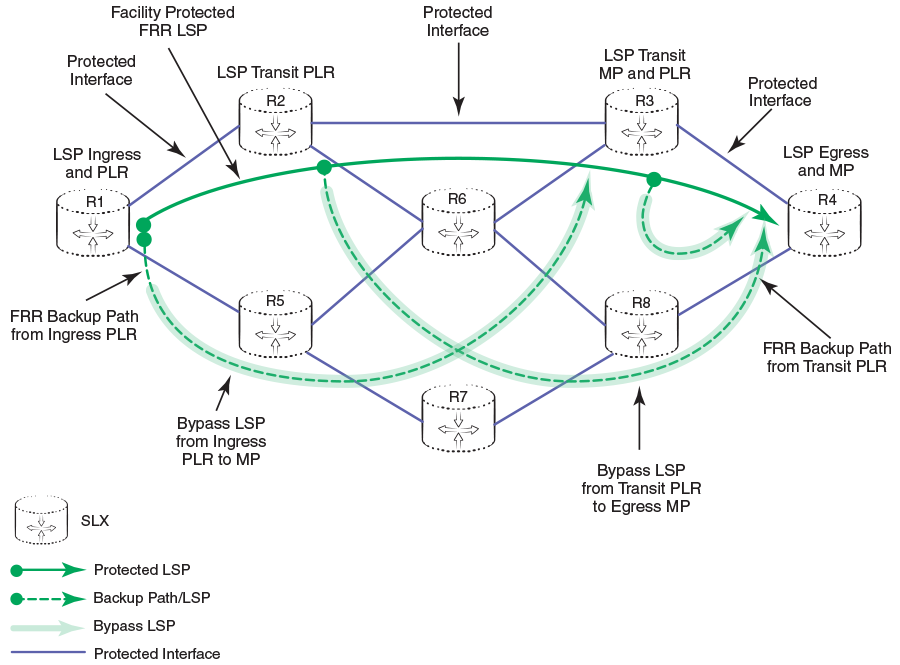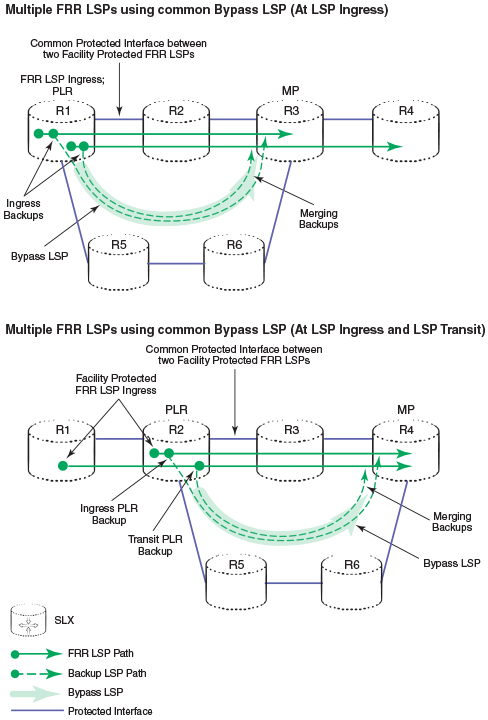Bypass LSP
MPLS LSP tunnels that are used to provide facility-backup FRR protection are known as bypass LSPs.
The bypass LSP acts as a virtual link between the PLR and the MP nodes in the network. More than one backup LSP can use a bypass LSP, providing that all the backup LSPs have a PLR, MP, or protected interfaces in common and the bypass LSP, and satisfy the backup LSP constraints such as node and links to be avoided, backup bandwidth, backup priority, and so on.
Bypass LSPs can protect all the facility backup FRR LSPs over an MPLS outgoing interface at a PLR. The interface to which the bypass LSP provides protection is called the protected interface or the exclude interface. A bypass LSP can also provide protection to a facility-backup FRR LSP on multiple interfaces.
The bypass LSPs provide interface protection for the FRR facility-protected LSPs per RFC 4090. Bypass LSPs can protect one or more interfaces, based on the type of bypass LSP.

SLX-OS supports two types of bypass LSPs, based on the way they are created:
- Static bypass LSPs
- Dynamic bypass LSPs
The user configures the static bypass LSPs similar to an LSP configuration. These bypass LSPs are operationally UP upon successful CSPF path computation and RSVP signaling. Persistence and restart behavior of the static bypass LSP are similar to regular LSPs.
Dynamic bypass LSPs are bypass LSPs that are created on demand. When a facility-protected FRR LSP requires a backup path to be up from its PLR to the MP, dynamic bypasses are created, providing that there are no existing bypass LSPs satisfying the backup path constraints. Dynamic bypass LSPs are deleted when they are unused for a certain amount of time.
The advantage of using a bypass LSP for FRR is that it improves the FRR scalability. A bypass LSP also provides a nearly hitless backup and, as a result, this improves network resiliency.
An FRR LSP is configured with a facility-backup option of the LSP configuration. This makes it a facility-backup (many-to-one) FRR LSP. The protection mechanism is node protection by default. Link protection can be explicitly configured using the link-protection command.
You configure the parameters of dynamically created bypass LSPs at the MPLS router mode configuration level, and the MPLS interface mode configuration levels. Dynamic bypass LSPs are deleted with a restart of the system.
A static or dynamic bypass LSP name is unique among bypass LSP names and regular LSP names in the router where the bypass LSP is being created. The bypass LSP RSVP sessions are similar to regular the LSPs.
Bypass LSPs are chosen by backup LSPs as per the FRR rules:
- The bypass LSP is protecting the outgoing interface of the protected LSP.
- The bypass LSP egress node is the Merge Point (MP) node of the requested backup.
- The bypass LSP is not using any of the FRR LSP links (downstream) from the ingress to the PLR.
- The bypass LSP is not using any of the FRR LSP nodes downstream between the PLR and the MP.
- The bypass LSP not using any of the FRR LSP nodes downstream between the MP and the LSP egress.
- The bypass LSP satisfies backup constraints such as the priority, bandwidth, exclude interface, exclude nodes, and so on.
The link protection FRR facility-protected LSP selects its MP in the order of next hop (NHOP), next-next hop (NNHOP), and so on until it reaches the egress node.
The node protection FRR facility protected LSP selects its MP in the order of next-next hop (NNHOP), next hop (NHOP), next-next-next hop (NNNHOP) and so on until it reaches the egress node.

The bypass LSP protects at least one interface. Such an interface is known as an exclude interface or a protected interface. There can be multiple bypass LSPs protecting an exclude- interface.
All facility protected LSPs outgoing through the exclude-interface can establish their backup LSP sessions on the bypass LSP provided that the bypass LSP reaches the same MP required by the FRR LSP backup LSPs, and the bypass LSP satisfies backup path and session constraints.

When an exclude interface goes down, all facility protected LSPs (outgoing through the exclude interface) and backup LSPs become active over the bypass LSP and start passing protected LSP traffic (along the PLR and the MP) over the bypass LSP.

